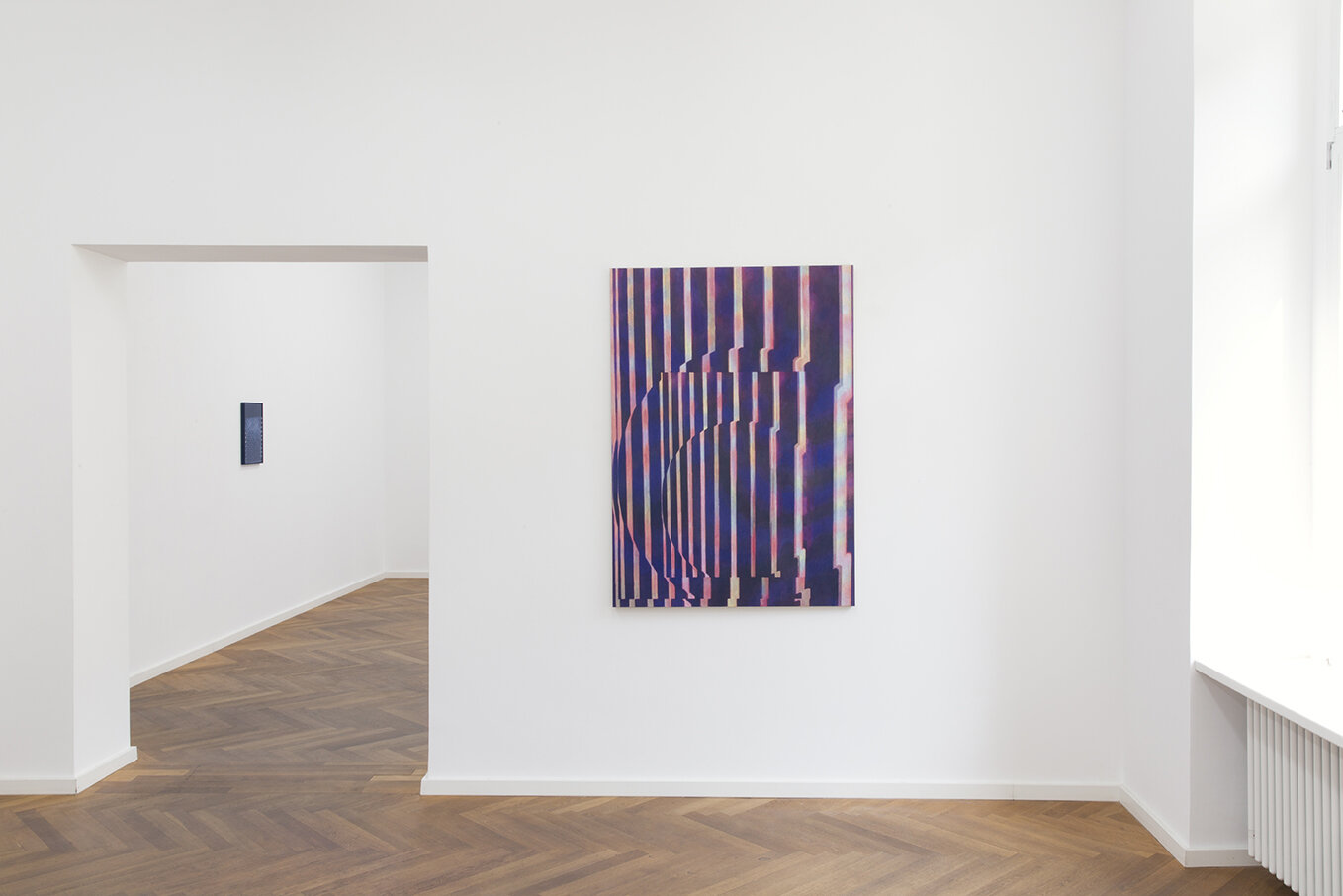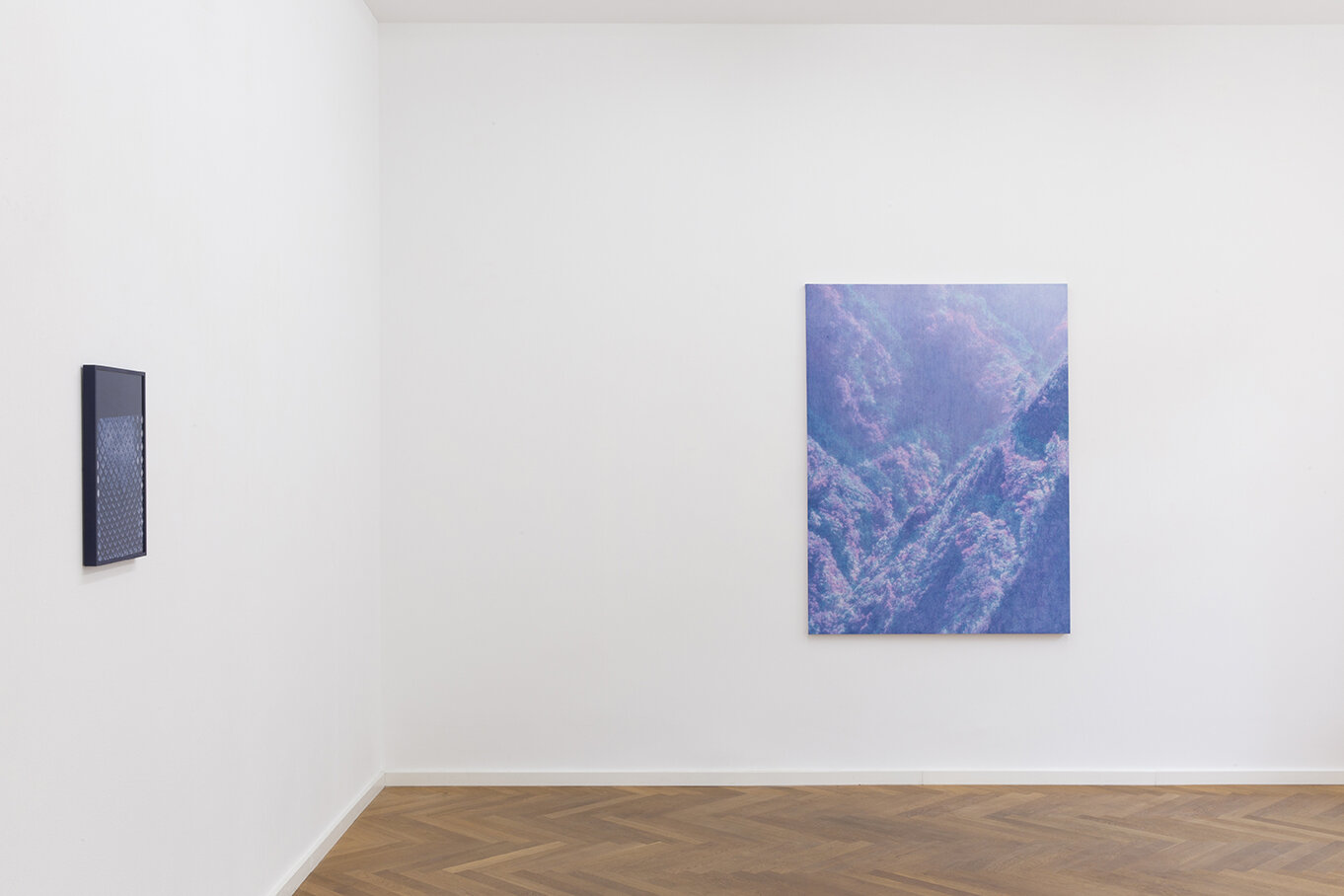Marcus Gundling
As I Please
Apr 21 - May 30, 2020
Marcus Gundling
As I Please
Apr 21 - May 30, 2020
It's a question as old as the history of photography itself: what is the relationship between painting and photography? Today the question could be specified: What is the relationship between painting and digital photography? In the works of Marcus Gundling's solo exhibition As I Please, both media are inextricably linked. Painting becomes a dark room. In it the artist develops his 'negatives', photographs processed on the computer, into object-like surfaces.
Marcus Gundling comes across countless images in the digital world of the Internet, from which he subjectively - As I please - selects and saves only a few. He often deletes annoying elements that actually determine the information content. This gesture is like a painterly one: he abstracts or removes (lat. Abstrahere = peel, separate, remove) the informative level of those parts of the picture that would often have remained undetected by the eye: backgrounds, details or special nuances. These modified images are Gundling's sketches. Sometimes the software editing tools become part of the image; as in his work “Ohne Titel” (2020): The large circular shapes come from the retouching tools in the program. The layered lamella levels within the painting are also traces of the processing options on the computer. In addition, the flickering over the painting refers to a moiré effect created between the camera and the screen, a marbled raster layer that also lies over the slats, circles and rectangles.
Gundling finally developed his photographic distillates in a complex, painterly process on various image carriers. Layer by layer, from light to dark, he works with ink, watercolors and synthetic resins. Similar to the development process in a dark room, his motifs appear ever more densely. The physically looming, glossy or transparent-waxed image areas arise from the reaction of the layers of color with the material painting grounds; it is only painterly that the codes of the 'digital negatives' appear completely. The work “Ohne Titel” (2020) shows roughly superimposed, bluish-dark and gray-pale grids. The motif in front and back is repeated in the layering of the picture carriers: Gundling paints the net structures on the canvas and on the plexiglass above. Analogous to the stacking of the image layers in Photoshop, but ultimately flat, i.e. remains in one area, the artist stacks his picture. Here the motif and the way of representation materialize into the object-like, the multi-layer surface.
The conceptual style of painting by the artist Marcus Gundling is not based on simplifying antagonisms, just as the world cannot be divided into a digital, analogue or real one today. In the connecting between the media of painting and digital photography, the artist - As I Please - develops very own possibilities of image generation. He creates works that testify to the complexity of the present.
Tarika Johar
The gallery will be open from Tuesday through Saturday between noon and 5 pm. We are looking forward to welcoming you during these hours.
—
Es ist eine Frage, so alt, wie die Geschichte der Fotografie selbst: Was ist das Verhältnis von Malerei und Fotografie? Heute ließe sich die Frage spezifizieren: Was ist das Verhältnis von Malerei und digitaler Fotografie? In den Werken von Markus Gundlings Einzelausstellung As I Please sind beide Medien untrennbar verbunden. Die Malerei wird zur Dunkelkammer. In ihr entwickelt der Künstler seine ‚Negative', auf dem Computer bearbeitete Fotografien, zu objekthaften Oberflächen.
Marcus Gundling stößt in den digitalen Weiten des Internets auf unzählige Bilder, aus denen er ganz subjektiv – As I please – nur wenige auswählt und abspeichert. Oftmals löscht er ihn störende Elemente, die eigentlich den Informationsgehalt bestimmten. Diese Geste gleicht einer malerischen: Er abstrahiert bzw. entfernt (lat. abstrahere = abziehen, trennen, entfernen) die informative Ebene von jenen Bildbestandteilen, die oftmals vom Auge unentdeckt geblieben wären: Hintergründe, Details oder besondere Nuancen. Diese modifizierten Bilder sind die Skizzen Gundlings. Zuweilen werden die Bearbeitungstools der Software Teil des Bildes; so in seiner Arbeit „Ohne Titel” (2020): Die großen Kreisformen entstammen den Retuschierwerkzeugen des Programms. Auch die übereinander geschobenen Lammellenebenen innerhalb der Malerei sind Spuren der Bearbeitungsmöglichkeiten am Rechner. Zudem verweist das sich über die Malerei ziehende Flirren auf einen zwischen Fotokamera und Bildschirm erzeugten Moiré-Effekt, eine marmorierende Rasterebene, die sich zusätzlich über die Lamellen, Kreise und Rechtecke legt.
Seine fotografischen Destillate entwickelt Gundling schließlich in einem aufwändigen, malerischen Prozess auf verschiedenen Bildträgern. Schicht um Schicht, vom Hellen ins Dunkle, arbeitet er mit Tusche, Aquarellen und Kunstharzen. Ähnlich des Entwicklungsvorgangs in einer Dunkelkammer treten so seine Motive immer verdichteter hervor. Die sich körperlich abzeichnenden, glänzenden oder transparent-wächsernen Bildflächen entstehen aus der Reaktion der Farbschichten mit den materiellen Malgründen; erst malerisch gelangen die Codes der ‚digitalen Negative‘ so vollends zur Erscheinung. Die Arbeit „Ohne Titel” (2020) zeigt etwa dicht übereinander liegende, bläulich-dunkle und grau-blasse Gitternetze. Das motivische Vorne und Hinten wiederholt sich in der Schichtung der Bildträger: Gundling malt die Netzstrukturen auf die Leinwand und auf das darüber liegende Plexiglas. Analog zur Stapelung der Bildebenen bei Photoshop, die aber letztlich flach, d.h. in einer Fläche bleibt, stapelt der Künstler sein Bild. Hier materialisieren sich Motiv und Darstellungsweise ins Objekthafte, zur mehrschichtigen Oberfläche.
So wenig wie sich heute die Welt in eine digitale oder analoge bzw. reale scheiden ließe, gründet die konzeptionelle Malweise des Künstlers Marcus Gundling auf vereinfachenden Antagonismen. In dem verbindenden Zwischen der Medien Malerei und digitale Fotografie entwickelt der Künstler – As I Please – ganz eigene Möglichkeiten der Bildgenerierung. Er schafft Werke, die von der Komplexität des Gegenwärtigen zeugen.
Tarika Johar
Die Galerie wird von Dienstag bis Samstag zwischen 12 und 17 Uhr geöffnet sein. Wir freuen uns, die begrüßen zu dürfen!


















